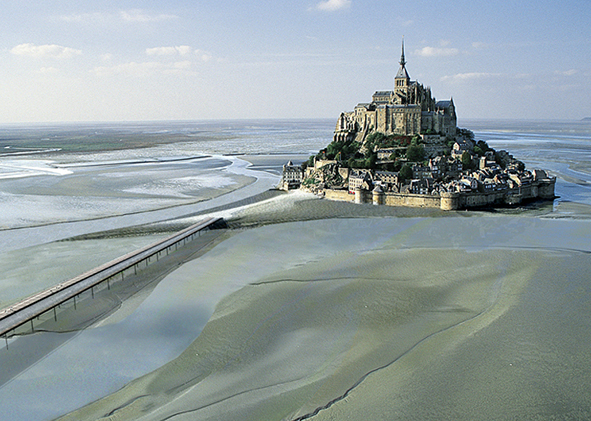Heritages in progress. Designing their regeneration
DOI:
https://doi.org/10.19229/2464-9309/852020Keywords:
heritage, regeneration, project, interdisciplinary, inter-scaleAbstract
To design with Heritage for the future within the complexity of its scales and its contemporary stakes opens an innovating field. The idea of ‘regeneration’ becomes a drive for project at all scales. The examination of this notion allows the introduction to the discourse, which is developed afterwards with the exposure of two meaningful experiments: they propose the current and future regeneration of Heritage within its large space context and open a new conceptual frame for the project. The case of Mont Saint Michel in France, a realized pilot project and the internationally collaborated academic works on the water supplies Heritage and the metropolitan sprawl in the territory of Jaipur-Amber, Rajasthan, illustrate the contribution to a founding reflection on the becoming of Heritages, seen as a renewable resource and innovative carrier.
Downloads
Article Metrics Graph
References
ANCSA – Associazione Nazionale per i Centri Storico-Artistici (1960), Carta di Gubbio. [Online] Available at: www.ancsa.org/in-sviluppo/wp-content/uploads/2020/01/Carta-di-Gubbio-1960.pdf [Accessed 29 November 2020].
Anupam, M. (2001), Tradition de l’eau dans le désert Indien – Les gouttes de lumières du Rajasthan, L’Harmattan, Paris.
Blanc, F. (2019), “Mont Saint Michel, Interroger le patrimoine à grande échelle, projets et développement contemporain”, in Chavardès B. and Dufieux, P. (eds), Les Enjeux Théoriques de la Réhabilitation – Actes du 3ème Séminaire du Réseau Architecture Patrimoine Création, École Nationale Supérieure d’Architecture de Lyon 1er- 2 décembre 2016, Presses architecturales de Lyon, Lyon, pp. 97-109.
Bonnet, F. (2016), Atouts Risques – Des territoires exposés se réinventent, Parenthèses, Marseille.
Borie, A., Catalàa, F. and Papillault, R. (2008), Jaipur – Ville nouvelle du XVIIIe siècle au Rajasthan, Thalia, Paris.
Choay, F. (1992), L’allégorie du Patrimoine, Le Seuil, Paris.
Delacroix, G. (2019), “L’Inde affronte une crise de l’eau annuelle, connaît un retard dramatique”, in Le Monde, 24/06/2019. [Online] Available at: www.lemonde.fr/climat/article/2019/06/24/en-inde-narendra-modi-affronte-une-crise-de-l-eau-sans-precedent_5480708_1652612.html [Accessed 29 November 2020].
Falini, P. E. (ed.) (2007), Lucus – Luoghi sacri in Europa, Programma Cultura 2000, Spoleto.
Gravari-Barbas, M. and Guichard-Anguis, S. (eds) (2003), Regards croisés sur le Patrimoine dans le monde à l’aube du XXIe siècle, Presses Universitaires de la Sorbonne, Paris.
Heyraud, E. (2010), La politique de la ville – Maîtriser les dispositifs et les enjeux, Berger-Levrault, Paris.
Khangarot, R. S. and Nathawat, P. S. (2018), Jaigarh, the Invincible Fort of Amber, RBSA Publishers, Jaipur.
Liévaux, P. and Hottin, C. (2016), “Les enjeux contemporains des sciences du patrimoine”, in Revue Culture et Recherche | Patrimoines, Enjeux Contemporains de la Recherche, n. 133, pp. 6-8. [Online] Available at: www.culture.gouv.fr/Sites-thematiques/Enseignement-superieur-et-Recherche/La-revue-Culture-et-Recherche/PATRIMOINES.-Enjeux-contemporains-de-la-recherche [Accessed 29 November 2020].
Marry, S. (2018), Territoires Durables – De la recherche à la conception, Parenthèses, Marseille.
Perruccioli, A. (1995), Dar al Islam – Architectures du territoire dans les pays islamiques, Mardaga, Bruxelles.
Rodrigues-Malta, R. (2001), “Régénération urbaine: variations sud-européennes”, in L’Information Géographique, vol. 65, n. 4, pp. 321-339. [Online] Available at: doi.org/10.3406/ingeo.2001.2774 [Accessed 29 November 2020].
Sanchari, P. (2016), “Modern India Can Learn a lot from These 20 Traditional Water Conservation Systems”, in The Better India, 15/07/2016. [Online] Available at: www.thebetterindia.com/61757/traditional-water-conservation-systems-india/ [Accessed 29 November 2020].
Secchi, B. and Viganò, P. (2011), La ville poreuse – Un projet pour le Grand Paris et la métropole de l’après-Kyoto, Métis Presses, Genève.
Terrin, J.-J. (ed.) (2015), Villes et Changement Climatique – Îlots de Chaleur Urbains | Cities and Climate Change – Urban Heat Islands, Parenthèses, Marseille.
TNN (2018), “Water Supply from Bisalpur to be cut by 50% from October 1”, in The Times of India, 05/07/2018. [Online] Available at: timesofindia.indiatimes.com/city/ajmer/water-supply-from-bisalpur-to-be-cut-by-50-from-october-1/articleshow/65680535.cms [Accessed 29 November 2020].

Downloads
Published
How to Cite
Issue
Section
License
This Journal is published under Creative Commons Attribution Licence 4.0 (CC-BY).
License scheme | Legal code
This License allows anyone to:
Share: copy and redistribute the material in any medium or format.
Adapt: remix, transform, and build upon the material for any purpose, even commercially.
Under the following terms
Attribution: Users must give appropriate credit, provide a link to the license, and indicate if changes were made; users may do so in any reasonable manner, but not in any way that suggests the licensor endorses them or their use.
No additional restrictions: Users may not apply legal terms or technological measures that legally restrict others from doing anything the license permits.
Notices
Users do not have to comply with the license for elements of the material in the public domain or where your use is permitted by an applicable exception or limitation.
No warranties are given. The license may not give users all of the permissions necessary for their intended use. For example, other rights such as publicity, privacy, or moral rights may limit how you use the material.


















































































